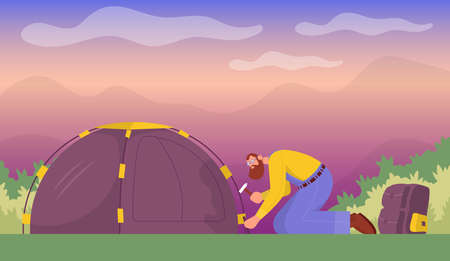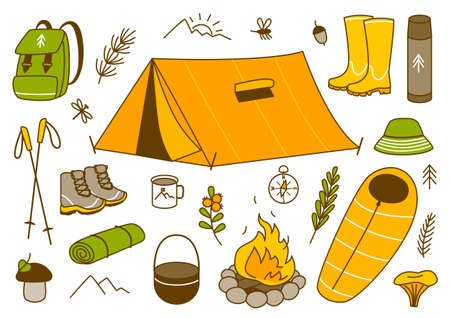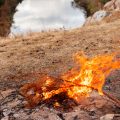1. Understanding the Basics of Campfire Safety
Before you strike a match or gather your first log, it’s crucial to understand the basics of campfire safety. Whether youre new to camping or a seasoned outdoor enthusiast, following fire safety practices helps protect you, others, and the wilderness we all love.
Know the Fire Regulations at Your Campsite
Fire rules can vary widely depending on where youre camping in the U.S.—national parks, state parks, private campgrounds, or backcountry sites may each have their own regulations. Always check with campground hosts or park rangers before starting a fire. In many areas, especially during dry seasons, fire bans might be in effect due to wildfire risk.
Common Campground Fire Rules:
| Location Type | Fire Regulations |
|---|---|
| National Parks | Fires allowed only in designated rings or grills; may be banned during high-risk periods |
| State Parks | Rules vary by state; check park website or visitor center for updates |
| Private Campgrounds | Often provide fire pits; follow posted guidelines and quiet hours |
| Backcountry Camping | Might require permits; use portable stoves if open fires are not allowed |
Choose a Safe Spot for Your Fire
Selecting the right location is key. Use established fire rings whenever possible. If one isn’t available, pick a clear, flat area at least 15 feet away from tents, trees, shrubs, and anything flammable—including low-hanging branches and dry grass.
Checklist for a Fire-Safe Location:
- Use existing fire rings or build one using rocks in a cleared area
- Avoid windy spots that can blow embers into dry brush
- Keep water or a shovel nearby in case you need to control the fire quickly
- Never build fires under overhanging branches or near tent fabric
How to Properly Extinguish Your Campfire
A fire isn’t truly safe until it’s completely out. Even small embers can reignite hours later and start wildfires. When its time to put out your campfire, follow this three-step method:
The “Drown-Stir-Feel” Method:
- Drown: Pour water on the fire until it stops hissing.
- Stir: Mix ashes and embers with a stick or shovel.
- Feel: Hover your hand over the ashes—if it’s still warm, repeat steps 1 and 2.
If water isnt available, use dirt or sand to smother the flames completely—but never leave a campfire unattended or assume its out without checking. Practicing these habits helps prevent forest fires and keeps future campers safe.
2. Gathering and Choosing the Right Materials
Before you strike that first match, having the right materials on hand is key to building a successful campfire. Whether youre in a national park or your own backyard, knowing what to gather—and how to prepare it—makes all the difference. Lets break down the basics of what youll need and how to find it in typical American wilderness settings.
Understanding Campfire Essentials
Every good campfire starts with three basic components: tinder, kindling, and fuelwood. Each plays a specific role in helping your fire catch, grow, and sustain itself.
Tinder
Tinder is your fire’s starting point. It needs to be dry and light so it catches flame easily from a match or lighter.
- Dried grass
- Pine needles
- Bark shavings (especially from birch or cedar)
- Cotton balls (for those bringing supplies)
Kindling
Once your tinder is burning, kindling helps build up the heat. Think of this as your medium-sized material—bigger than tinder but not yet full logs.
- Small twigs (about pencil thickness)
- Split sticks no wider than your thumb
- Pinecones (great for quick ignition)
Fuelwood
This is what keeps your fire going over time. You want dry, seasoned wood that burns slow and steady.
| Type of Wood | Common Locations | Burn Characteristics |
|---|---|---|
| Oak | Eastern U.S., Appalachian regions | Slow-burning, high heat output |
| Maple | Northeast and Midwest forests | Long-lasting burn, minimal smoke |
| Pine | Throughout U.S., especially South & West | Lights easily, burns fast with crackle |
| Cedar | Pacific Northwest & Southwest deserts | Aromatic, splits easily, moderate burn time |
| Aspen | Rocky Mountains & Western states | Lighter burn, good for early fires or mixing in |
Tips for Collecting Materials in the Wild
1. Look for Dead and Downed Wood Only
Avoid cutting live trees—even small branches—as they contain moisture and wont burn well. Plus, many parks prohibit damaging live vegetation.
2. Keep It Dry
If its been raining, check under pine trees or large rocks where wood may have stayed dry. Carry a small bag to store dry materials when you find them.
3. Snap Test for Dryness
Bend twigs—if they snap cleanly instead of bending, they’re dry and ready to burn.
A Quick Checklist Before You Light Up:
- Tinder: Dry grass, bark shavings, or cotton balls?
- Kindling: Pencil-thick twigs and pinecones?
- Fuelwood: A mix of hardwoods and softwoods ready?
- Sourced legally and responsibly?
The better prepared you are with the right materials, the easier it’ll be to get a warm, lasting fire going—whether youre cooking dinner or just relaxing under the stars.

3. Popular Campfire Structures and When to Use Them
Building the right kind of campfire isnt just about getting a flame going—its also about matching the fire structure to your camping situation. Whether youre boiling water, cooking dinner, or just looking to stay warm, choosing the best fire setup can make all the difference. Let’s break down the most popular campfire structures you’ll come across in American camping culture and when each one works best.
Teepee Fire
The teepee is probably the most classic and beginner-friendly fire structure. It’s shaped like a cone with kindling and tinder at the center, surrounded by sticks leaning inward like a tipi (teepee).
When to Use:
- Quick warmth or light
- Starting a fire easily
- Dry weather conditions
Tips:
- Use dry, thin kindling for faster ignition
- Great as a base to transition into other fire types
Log Cabin Fire
This build stacks logs in a square shape like Lincoln Logs, with a small teepee of kindling inside. It burns slower and more steadily than a teepee fire.
When to Use:
- Cooking meals over an even heat
- Long-lasting fires
- Damp or windy conditions (more stable)
Tips:
- Keep gaps between logs for airflow
- Add larger logs as outer layers for longer burn time
Lean-To Fire
The lean-to involves placing a large log as a windbreak, then leaning smaller sticks against it with tinder underneath. Its ideal when battling wind or limited materials.
When to Use:
- Windy environments
- You need to get a fire started fast with minimal fuel
Tips:
- Shelter the tinder from wind using your body or gear while lighting
- Gradually add sticks once the flame catches on
Comparison Table: Which Campfire Structure Should You Choose?
| Campfire Type | Best For | Burn Duration | Ease of Building | Weather Suitability |
|---|---|---|---|---|
| Teepee Fire | Quick warmth/light, beginners | Short to Medium | Easy | Dry conditions preferred |
| Log Cabin Fire | Cooking, steady heat, long burn | Long-lasting | Moderate effort | Damp or breezy conditions ok |
| Lean-To Fire | Windy weather, fast starts with little fuel | Short to Medium | Easy to Moderate | Great for wind protection needs |
No matter what structure you choose, always be mindful of your surroundings. Pick a safe spot away from flammable materials and follow local fire regulations. With these classic builds in your skillset, youll be ready to adapt your campfire game to any adventure.
4. Lighting Techniques That Actually Work
Getting your campfire lit efficiently is just as important as building it right. Whether youre a weekend camper or a seasoned backcountry pro, knowing how to reliably start a fire can make or break your outdoor experience. Below are tried-and-true methods used by experienced U.S. campers to get the flames going, even in less-than-ideal conditions.
Using Matches
Matches are classic and easy to carry, but they require dry conditions and proper technique.
Step-by-Step: Lighting with Matches
- Use strike-anywhere or waterproof matches for reliability.
- Strike the match away from your body and shield it from wind with your hand or body.
- Hold the match under your tinder bundle at an angle so the flame rises into the material.
- Once the tinder catches, gradually add kindling without smothering the flame.
Using Lighters
Lighters are convenient and more wind-resistant than matches. BIC lighters are a favorite among U.S. campers for their reliability.
Step-by-Step: Lighting with a Lighter
- Flick the lighter to create a steady flame.
- Place the flame under your tinder bundle, again shielding from wind if needed.
- Once you see smoke or small flames, slowly feed in kindling and then larger wood pieces.
Using Ferro Rods (Fire Starters)
Ferrocerium rods, often called ferro rods, are popular among survivalists and backpackers due to their durability and performance in wet weather.
Step-by-Step: Lighting with a Ferro Rod
- Create a small pile of dry tinder like cotton balls, dryer lint, or shaved bark.
- Hold the ferro rod close to the tinder at about a 45-degree angle.
- Scrape down the rod with a metal striker or knife blade using firm pressure to create sparks.
- Aim the sparks into the center of the tinder until it ignites.
Comparison Table of Fire-Starting Tools
| Tool | Pros | Cons |
|---|---|---|
| Matches | Lightweight, simple | Ineffective when wet; wind-sensitive |
| Lighters | Easy to use, reusable | Loses fuel over time; less effective in extreme cold |
| Ferro Rods | Works when wet; long-lasting | Takes practice; requires good tinder prep |
Pro Tips from U.S. Campers
- Always carry at least two fire-starting methods—redundancy is key in unpredictable weather.
- Add petroleum jelly to cotton balls for an ultra-reliable homemade fire starter.
- A small piece of fatwood or commercial fire starter block can be a lifesaver in damp environments.
No matter which method you choose, preparation is everything. Make sure your tinder is dry and fluffy, your kindling is nearby, and youve built your fire structure before striking that first spark. Mastering these lighting techniques will ensure youre never left in the cold on your next camping trip.
5. Campfire Cooking Made Simple
Theres nothing quite like the smell of food sizzling over an open flame. In American camping culture, campfire cooking is more than just a way to eat—its a big part of the outdoor experience. Whether youre a beginner or a seasoned camper, mastering this skill adds comfort and fun to your adventures. Heres how you can keep it simple and satisfying.
Must-Have Tools for Campfire Cooking
Before you start cooking, make sure you have the right gear. You dont need a ton of fancy equipment—just a few key items that can handle the heat and make your life easier at the campsite.
| Tool | Purpose |
|---|---|
| Cast Iron Skillet | Perfect for frying, sautéing, and baking directly over the fire. |
| Grill Grate | Lets you cook burgers, hot dogs, or vegetables evenly over flames. |
| Long-Handled Tongs | Keeps your hands safe while turning food over the fire. |
| Heat-Resistant Gloves | Protects your hands when handling hot cookware or moving logs. |
| Foil Packets | Great for easy meals with minimal cleanup—just wrap and roast. |
Easy Recipes to Start With
If youre new to campfire cooking, start with tried-and-true American favorites that don’t require much prep or special ingredients.
Classic Foil Packet Dinner
- Ingredients: Ground beef or sausage, diced potatoes, carrots, onions, salt & pepper.
- Instructions: Wrap everything in foil, seal tightly, and cook on coals for about 25–30 minutes.
Smores (Of Course!)
- Ingredients: Graham crackers, chocolate bars, marshmallows.
- Instructions: Roast marshmallow on a stick until golden brown, sandwich between graham crackers with chocolate inside.
Pancakes Over Fire
- Ingredients: Pancake mix (add water only type), butter or oil.
- Instructions: Heat skillet over fire, pour batter in small rounds, flip when bubbles form on top.
Controlling Heat Like a Pro
The secret to great campfire cooking isn’t just what you cook—it’s how you control the heat. A roaring flame might look impressive but it’s not ideal for most meals. Here are some quick tips:
- Create Heat Zones: Push some of the burning wood to one side to create areas with different temperatures—hot for searing, medium for roasting, low for keeping things warm.
- Cook on Coals: Let your fire burn down to glowing embers before starting. They provide steady heat without flare-ups.
- Avoid Flames: Flames can burn food quickly. Aim to cook over coals instead of direct flame unless youre roasting something like marshmallows or hot dogs.
With these basics under your belt, youll be well on your way to enjoying hearty meals around the fire—just like generations of American campers have done before you.

